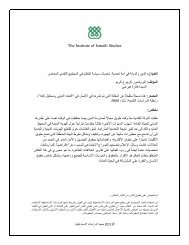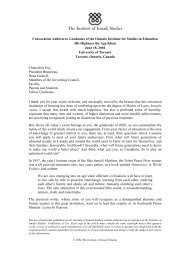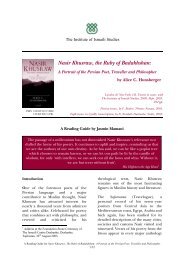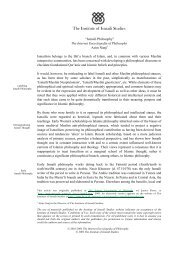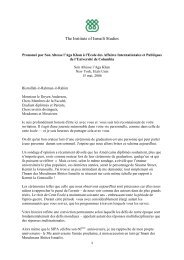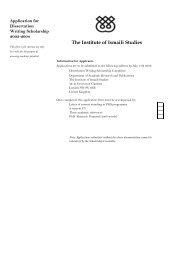The Institute of Ismaili Studies 1
The Institute of Ismaili Studies 1
The Institute of Ismaili Studies 1
Create successful ePaper yourself
Turn your PDF publications into a flip-book with our unique Google optimized e-Paper software.
among the bedouins and the Persian emigrants (Ibn al-Dawadari, VI, pp. 55-62, 91 ff.; Maqrizi,<br />
Itti‘az, I, pp. 159 ff.; Nuwayri, XXV, pp. 233 ff.; Tabari, III, pp. 2188 ff., 2196-97, 2205, 2232;<br />
Tabari, tr. XXXVIII, pp. 77 ff., 86-89, 98, 128-29; Mas‘udi, Muruj, VIII, pp. 191 ff.; de Goeje, pp.<br />
33-47,69 ff.)<br />
In the early 260s AH/870s CE, the da‘wa was taken to the region <strong>of</strong> the Jibal in Persia by Khalaf al-<br />
Hallaj, who established himself in Rayy. <strong>The</strong>re, the <strong>Ismaili</strong>s became known as the Khalafiya. Under<br />
Khalaf’s successors as chief da‘is <strong>of</strong> the Jibal, the da‘wa spread to Qum, Kashan, Isfahan, Hamadan<br />
and other towns <strong>of</strong> that region. Giat, the third da‘i <strong>of</strong> Rayy, extended the da‘wa to Khurasan and<br />
Transoxania on his own initiative. But the da‘wa was <strong>of</strong>ficially established in Khurasan during the<br />
last decade <strong>of</strong> the 3rd century AH (the first decade <strong>of</strong> the 9th century CE) by Abu ‘Abd-Allah Khadim<br />
who set up his secret headquarters at Nishabur. A later chief da‘i <strong>of</strong> Khurasan, Husayn b. ‘Ali<br />
Marwazi was an eminent amir in the service <strong>of</strong> the Samanids and he succeeded in extending the<br />
da‘wa to Hirat, Gur and other localities under his control, (Nizam-al-Mulk, pp. 282-95, 297-305; tr.<br />
Darke, pp. 208-18, 220-26; Ibn al-Nadim, ed. Tajaddud, p. 239; Bagdadi, Farq, ed. Badr, p. 267;<br />
Stern, 1960, pp. 56-90; repr. in — — , 1983, pp. 189-233).<br />
By the early 280s AH/890s CE, a unified <strong>Ismaili</strong> movement had replaced the earlier <strong>Ismaili</strong> groups.<br />
But in 286 AH/899 CE, soon after Imam ‘Abd-Allah al-Mahdi, the future Fatimid caliph, had<br />
succeeded to leadership in Salamiya, <strong>Ismaili</strong>sm was wrought by a major schism. Hamdan now noticed<br />
significant changes in the doctrinal instructions he received from Salamiya, and dispatched ‘Abdan<br />
there to investigate the matter. Hamdan found out that instead <strong>of</strong> advocating Imam Muhammad b.<br />
Ismail as Mahdi, the new leader now claimed the imamate for himself and his predecessors, the<br />
central leaders <strong>of</strong> the <strong>Ismaili</strong> da‘wa in the dawr al-satr. Hamdan and ‘Abdan refused to accept this<br />
doctrinal change, allowing for continuity in the imamate. <strong>The</strong>y renounced their allegiance to the<br />
central leadership <strong>of</strong> <strong>Ismaili</strong>sm and suspended all da‘wa activities in Iraq. Soon after, Hamdan<br />
disappeared while ‘Abdan was murdered at the instigation <strong>of</strong> a subordinate da‘i, Zikrawayh b.<br />
Mihrawayh, who initially remained loyal to Salamiya (Ibn al-Dawadari, VI, pp. 65-68; Maqrizi,<br />
Itti‘az, I, pp. 167-68; Nuwayri, XXV, pp. 227-32; Ibn Hawqal, p. 295; tr. Kramers and Wiet, II, p.<br />
289; Madelung, 1961, pp. 59-65,69 ff.; Daftary, 1993, pp. 123-39).<br />
Imam ‘Abd-Allah al-Mahdi’s reform is explained in a letter he later sent to the <strong>Ismaili</strong> community in<br />
Yemen (see H. F. al-Hamdani, 1958; also Hamdani and de Blois, 1983), in which an attempt is made<br />
to reconcile his reform with the actual course <strong>of</strong> events in pre-Fatimid <strong>Ismaili</strong> history. He explains that<br />
as a form <strong>of</strong> taqiya, the central leaders <strong>of</strong> the da‘wa had assumed different pseudonyms, such as al-<br />
Mubarak and al-Maymun, also assuming the rank <strong>of</strong> hujja, pro<strong>of</strong> or full representative, <strong>of</strong> the absent<br />
Imam Muhammad b. Isma‘il. Imam ‘Abd-Allah, whose own pseudonym had been al-Sa‘id, the Happy<br />
One, further explained that the earlier propagation <strong>of</strong> Imam Muhammad b. Isma‘il as Mahdi was itself<br />
another dissimulating tactic and that this was in reality another collective pseudonym for every true<br />
imam in the progeny <strong>of</strong> Imam Ja‘far al-Sadiq. <strong>The</strong> statements <strong>of</strong> Imam ‘Abd-Allah are corroborated<br />
by the few surviving early <strong>Ismaili</strong> sources (see, for instance, Ja‘far b. Mansur al-Yemen, Kitab al-<br />
Kashf, pp. 97-99, 102 ff., 109-10, 135, 160; also Madelung, 1961, pp. 254-58).<br />
<strong>The</strong> doctrinal reform <strong>of</strong> Imam ‘Abd-Allah al-Mahdi split the <strong>Ismaili</strong> movement into two rival factions.<br />
One faction remained loyal to the central leadership and acknowledged continuity in the imamate,<br />
recognising Imam ‘Abd-Allah and his ‘Alid ancestors as their imams, which was in due course<br />
incorporated into the Fatimid <strong>Ismaili</strong> doctrine <strong>of</strong> the imamate. <strong>The</strong>se <strong>Ismaili</strong>s now allowed for three<br />
hidden imams (al-a’imma al-masturin) between Imam Muhammad b. Isma‘il and Imam ‘Abd-Allah<br />
…Please see copyright restrictions on page 1<br />
4



